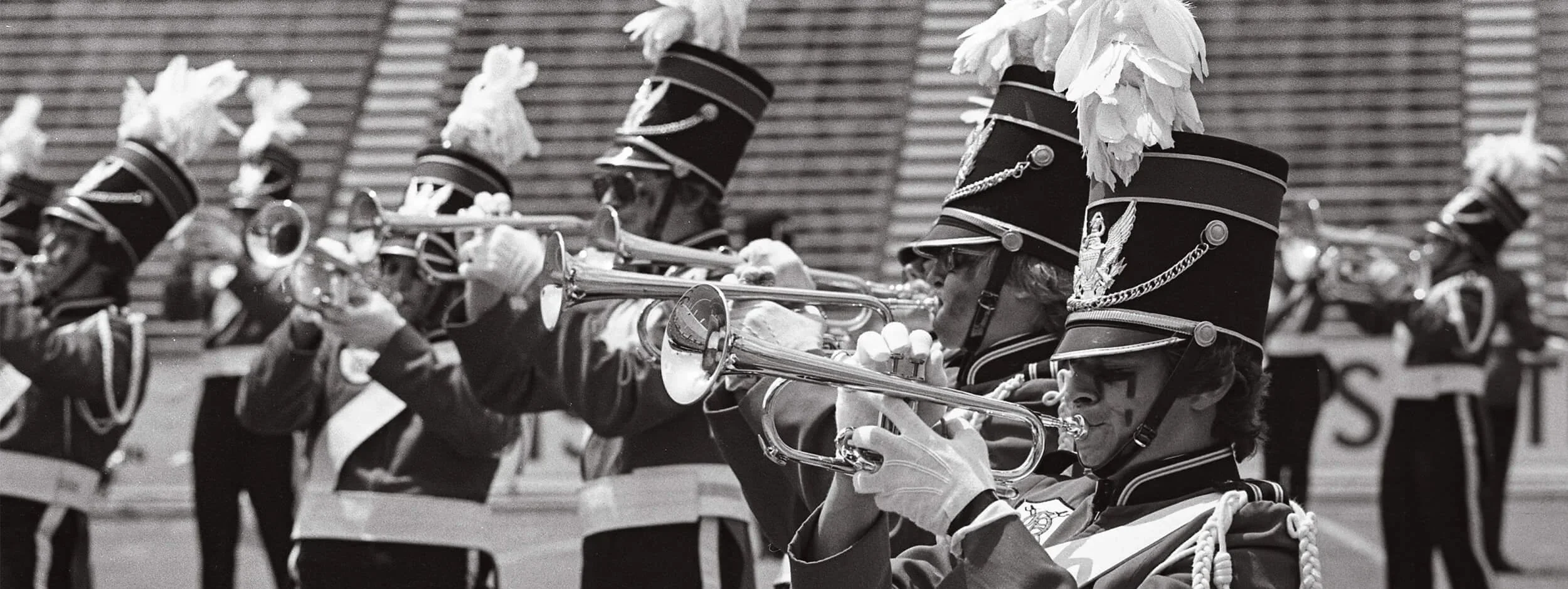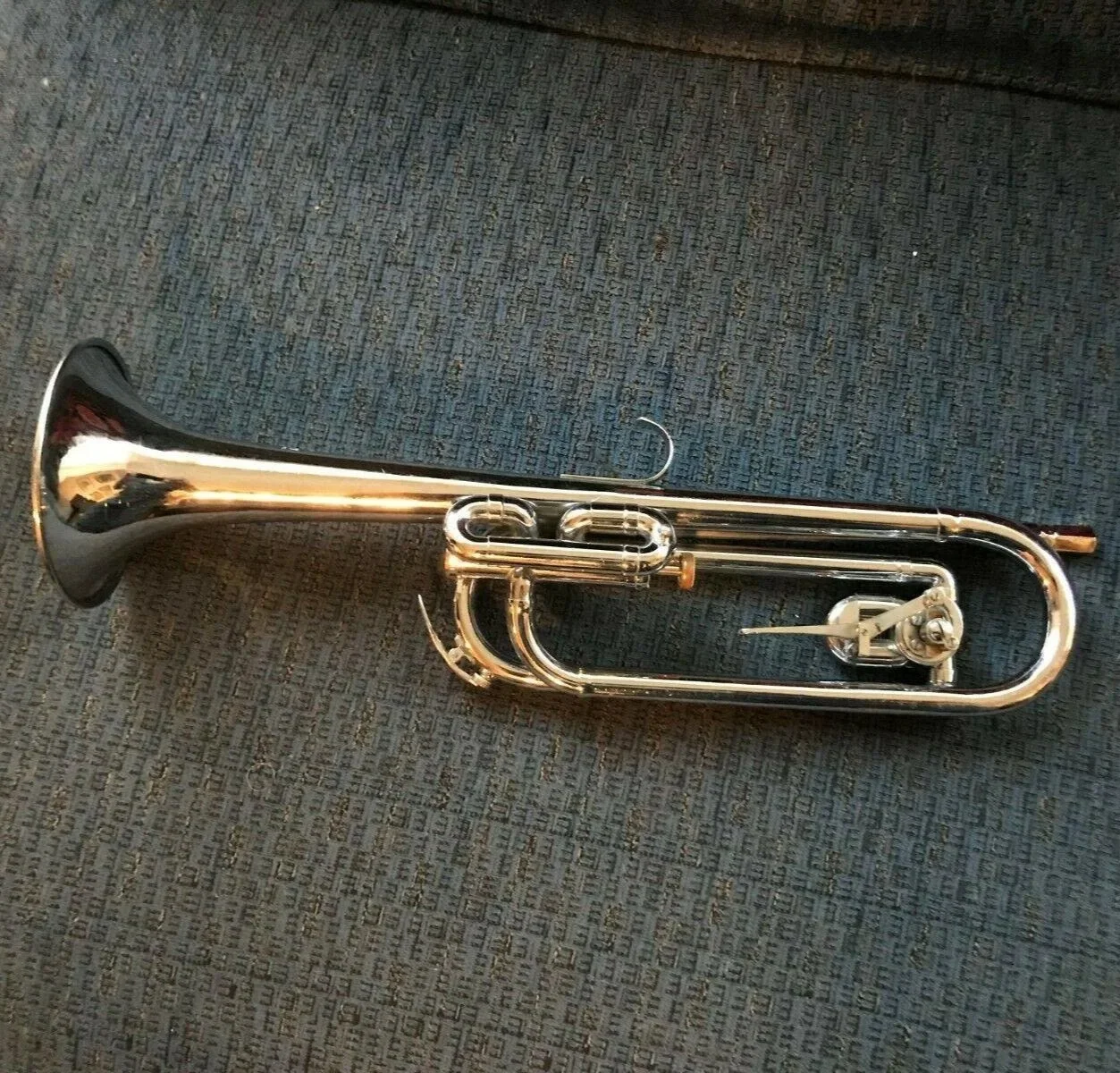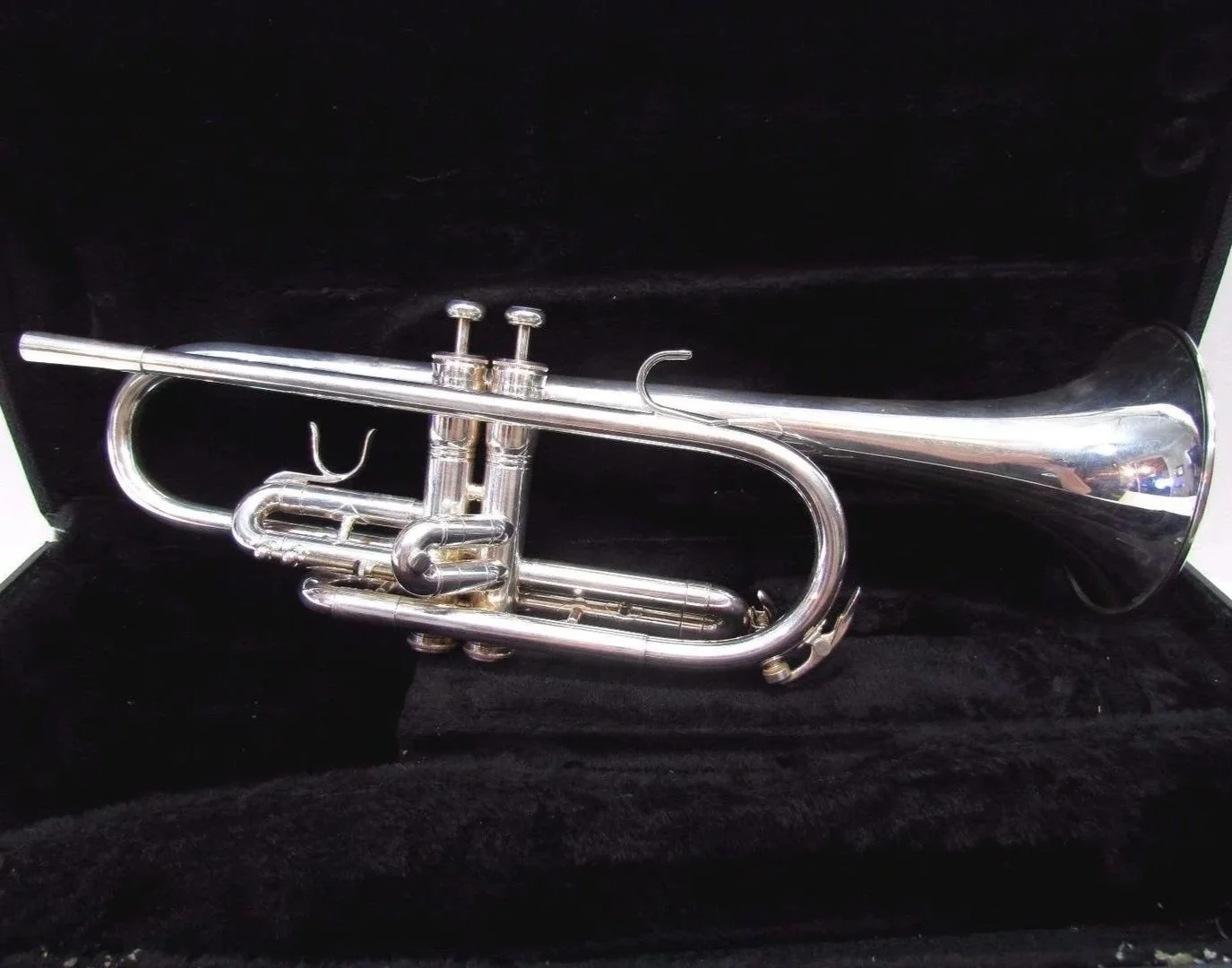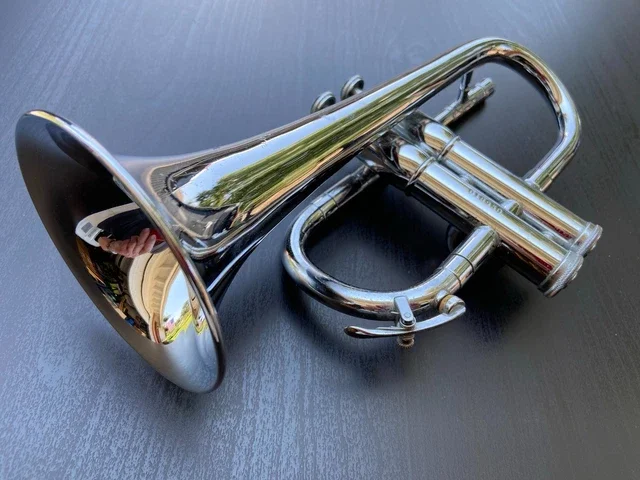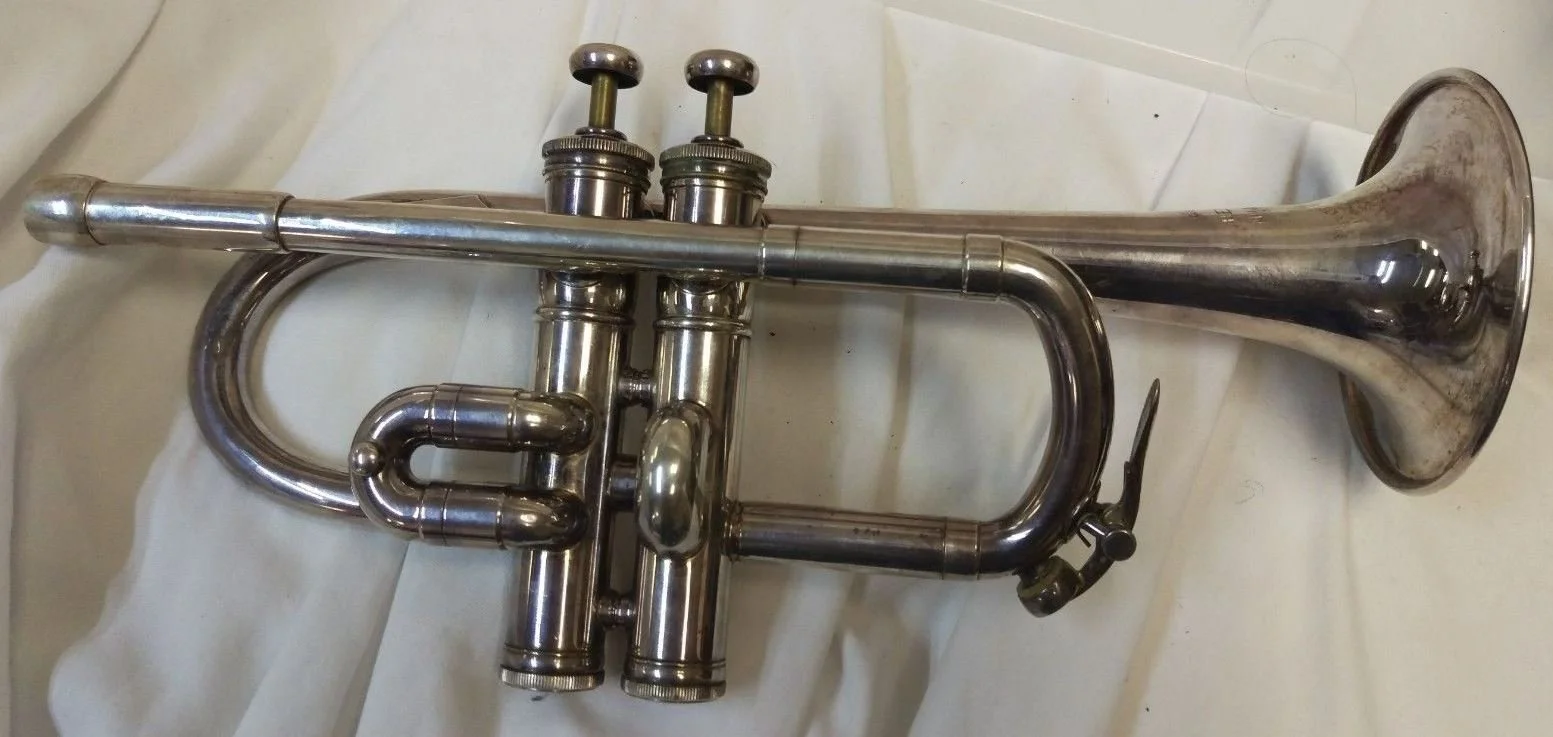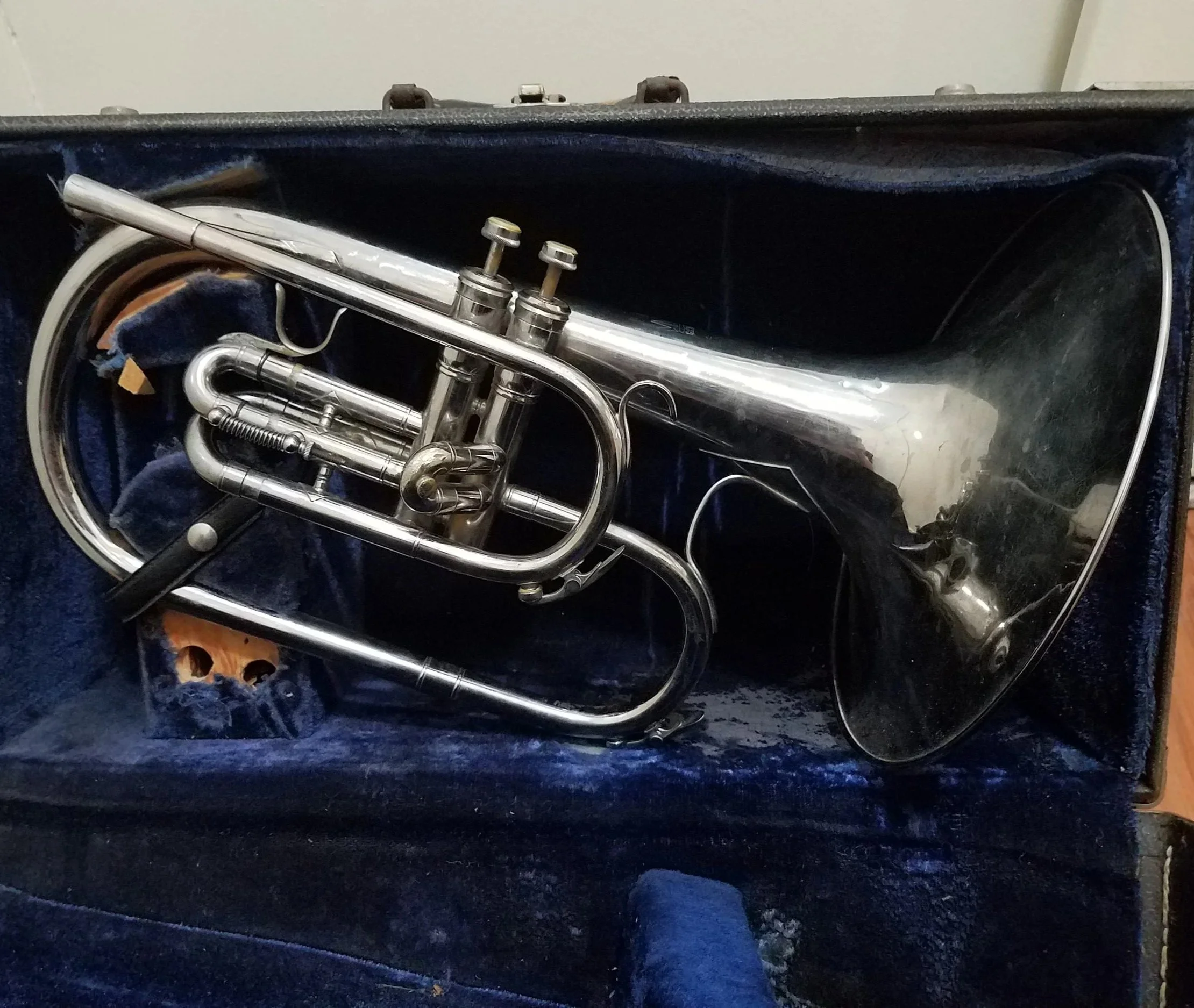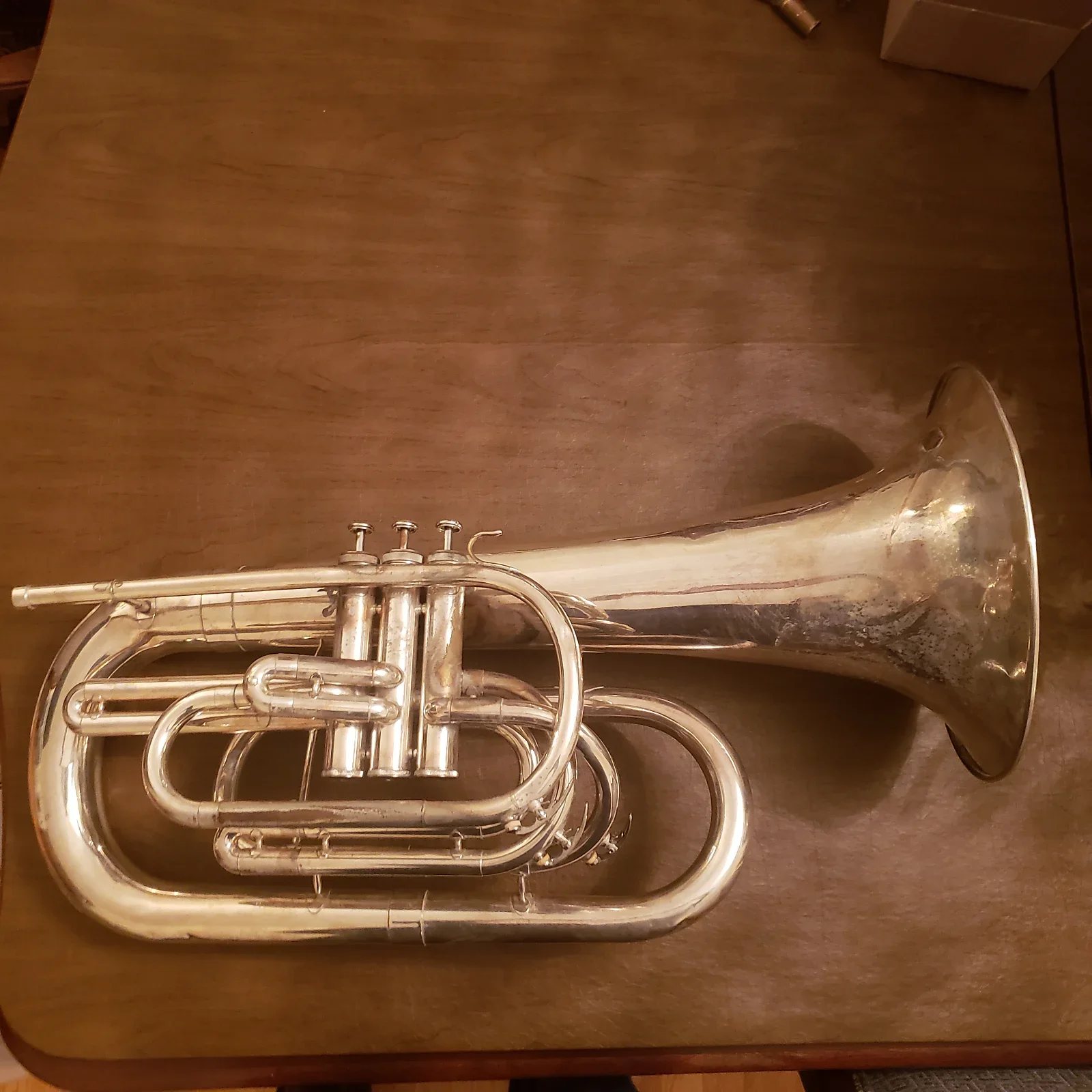G Bugles
If you’ve been wandering around my website and have noticed a fair bit of content regarding a bunch of weird bugles in G and want to know what that’s about, if you’re interested in G bugles and want to know which ones could be the most useful, or if you’re deep into the G bugle game and you just want to consume as much G bugle content as possible, this article is for you.
I’ll start with a very brief history lesson and a definition of what exactly a G “bugle” really is.
Civilian drum and bugle corps in the United States began after World War I, initially using actual valveless military bugles for the brass line. Eventually they started adding valves to the bugles, which were only allowed to be in the key of G. First came a single horizontal piston, then 1 piston and 1 rotor, 2 pistons, and finally 3 pistons. Each change came after a long and laborious process of arguing for and against The Tradition™, a drum corps pastime that continues to this day.
Along with valves, new brass voices were gradually added to the allowed instrumentation, and while many of them were not at all bugles, they were still called bugles. (For this reason I like referring to the “family” as a whole as competition bugles, rather than just bugles.) This resulted in fun names like “French horn bugle” and “trombonium bugle” that sound like they came from a Dr. Seuss book. Weird naming scheme aside, drum corps instrumentation was rife with experimentation until the year 2000, when the rules were changed to allow brass instruments in any key, instead of just G.
Drum corps is a pretty insular activity, and as a result most brass players who aren’t into drum corps don’t know much (if at all) about the G bugles. I myself never marched, and so my main interest in G bugles has always been “which of these instruments is useful outside of drum corps?”, and that’s mainly what this article is about. I have been fortunate to own a smattering of ultra-cool, ultra-rare G bugles in the past few years, and have used a few of them in very not-drum-corps environments, so I feel like I can answer that question pretty well at this point. If you are a G bugle collector, this information and advice probably does not apply to you. Let’s dive in!
Soprano Bugle
The soprano bugle was the top voice of the G hornline. These are essentially trumpets in G with an extra large bore and bell throat, and they are SCREAMERS. If that sounds appealing, you would probably enjoy a 2-valve soprano. The 2 valve horns are extremely light and extremely free-blowing, and if you’re playing screamer parts you don’t need the 3rd valve. Look for a King K-20 or Dynasty II.
However, I believe the soprano bugle’s real niche outside of drum corps is the LOW notes. Put an extra-large mouthpiece into a 3-valve soprano and you have an excellent G alto trumpet. With the huge scarcity of real alto trumpets in F or E-flat, a 3-valve G soprano bugle (which you can easily pick up online for around $200) is a legitimately useful tool for a trumpet player, or an interesting left-field choice for someone looking to add a high brass instrument to their stable.
While I would definitely recommend holding out for a 3-valve for the reasons above, an ultra-cheap 2-valve soprano is not a bad pickup either. It is fully chromatic at sounding E4 and above, which can still be useful (especially if you already have a trumpet). Just don’t spend very much!
Piccolo Soprano Bugle
These are an octave above the G soprano bugle, and are very rare. Almost all of them have two valves, making them chromatic only down to sounding E5. An interesting curiosity yet ultimately not worth looking for, especially as if one does show up for sale it will not be cheap.
Flugelhorn Bugle
Flugel bugles are not a common type of bugle, but they did see quite a bit of use in the 2-valve era. As the flugelhorn’s strength is the middle register and not the high register, I tend to think 2-valve flugel bugles are not very useful. That said, if you really want a flugelhorn and can’t find a dirt cheap one in Bb, a 2-valve G flugel bugle might be your cheapest way into a playable, nice-sounding flugelhorn. Do not show up to any kind of gig with one, but for home use and multitracking it can be a great option for the right price (no more than $200). You get the same lowest note (sounding E3) as a Bb flugel and just have 4 missing notes (Ab3-Bb3, Eb4) above that, but if you have any other mellow alto instruments that’s easy to write around. For 2-valve flugel bugles, look for the King K-30 or Dynasty II.
As for 3-valve flugelhorn bugles, they barely exist. Dynasty had one model, but it’s just a Signature 2000 Bb flugel with tubing added, which is not a good recipe. Kanstul did make at least one, but it was not a standard part of their catalog. Yamaha made a full set for the Blue Devils in 1992, but they were just modified Bb flugels. If you want a 3-valve flugel-like instrument, look to the alto bugle instead.
Alto Bugle
The alto bugle is usually a mellophone with a smaller bell, but the older ones (particularly the 2-valve Dynasty II Alto/Symphonic or the impossibly rare Dynasty III 3-valve version) are essentially big flugelhorns in G. A bit more horn-like when pushed, but otherwise all flugel. However, as the 2-valve is missing the same notes as a 2-valve flugel bugle (and is very rare), and the 3-valve I used to own is the only example I’ve seen of that model ever existing, these older (1970s) Dynasty alto bugles are not something to bet on.
The more common smaller bell mellophone type (King K-40 2-valve, Kanstul 175, later Dynasty II, later mellophone-wrap Dynasty III), is an interesting beast. With an alto horn mouthpiece, they sound like an even sweeter flugelhorn. However, they were usually designed around a marching mellophone mouthpiece, which means they can play far too flat to be usable when you use an alto horn mouthpiece. My early-pattern Kanstul KAB-175 was this way. I could only use a marching mellophone mouthpiece like it was designed for, and it played exceptionally well with that, but no longer sounded anything like a flugelhorn. Instead, the sound you get with that combination is more like a cross between mellophone and trumpet. It is certainly a unique and interesting sound, but not one that I would call useful. I’d love to hear it in a jazz combo or pop horn section, though.
Mellophone Bugle
The G mellophone bugle was originally inspired by the Conn 16E mellophoniums used in the Stan Kenton band, and the modern F marching mellophone was developed from the G mellophone bugle. With great F mellophones like the Yamaha YMP-204M readily available, is the G mellophone useful?
In my opinion, a G is useful only if you play a lot of screamer mellophone parts. I used to own a King K-50 2-valve G mellophone, the screamiest of all mellophones, and it was great fun to play screamer parts on. It is the sports car of the mellophone world. I eventually sold it because it didn’t offer enough of a difference from my other mellophones, but I had a ton of fun with it. If you can find a K-50 for a great price and want to give it a shot, I can guarantee you’ll have a great time with a K-50 or a 3-valve G mellophone (Dynasty or Kanstul) if you like playing very high on mellophone.
What I would not recommend is buying a G mellophone as your only mellophone. Get a good F marching mellophone, like a cheap King 1120 from eBay, so that you can have a workhorse that you can read existing mellophone or horn parts with. Then, if you want, pick up a G mellophone (2 or 3 valve) to add some more brightness and high note security to your mello arsenal.
Meehaphone
Kanstul MFL meehaphone
The meehaphone is the most famous of the weird and ultra-rare G bugles. Made for Kanstul for the Blue Devils in 1987, the meehaphone is essentially a bell-front descant horn in G with 2 valves. I was fortunate enough to own the only known meehaphone not in a museum for a while, and while it was very cool it was not very useful. The instrument’s forte is its middle register, with the high register being weak and unstable. But since it only has 2 valves, that middle register is only fully chromatic for less than an octave! A 3-valve meehaphone built from parts would be interesting, but if you’re doing that you’re in pretty deep.
French Horn Bugle
The French horn bugle was one of the standards of the DCI hornline in the 2-valve era, partly because it unlocked a lot of the missing pitches the mellophones had. Because it was built an octave lower than other mid-voice bugles, it was the only kind of bugle that really never needed 3 valves on the field. The lowest chromatic pitch (sounding E3) on a 2-valve “Frenchie” is far below what you would see in a typical drum corps French horn book.
However, because the French horn bugles were nearly as long as a single F horn, they were very easy to crack notes on while running across a football field. But are they useful off the field?
If you’re playing a live gig on multiple brass instruments where you are playing into a mic and need to cover some French horn parts, a marching horn is exactly what you need as the bell points the right way for the mic. But Bb marching horns exist and are plentiful, so why go for the G? Most of the time I would say you don’t need to, especially as 2-valve Gs don’t typically go for any cheaper than 3-valve King Bbs on eBay. However, the G really does sound very close to a concert horn, and the Bb is not as close. So if you want a really convincing horn sound for a mic placed in front of you, the G French horn bugle (King K-60, Dynasty II) could be your best bet.
While 2 valves is more than enough for field use, if you happen to come across one of the enormously rare 3-valve G French horn bugles (Kanstul KHB-185, Dynasty III) at a good price, that 3rd valve is obviously nice to have. That said, on the only gig I’ve had where I would have used my G French horn bugle if I had it at the time, I actually would have only needed 2 valves.
Low Alto Bugle
Kanstul low alto bugle
The low alto bugle is one of the oddest and rarest G bugles out there. It was made by Kanstul at the start of the short 3-valve era, and so few were made (6 total) that it didn’t even get a model number. It is essentially a Kanstul KHB-185 3-valve G French horn bugle with a trumpet shank, which sounds like it would just be a 185 but worse. However, the truth is much more interesting. Many kinds of mouthpieces will fit (trumpet, mellophone, alto horn, small trombone, French horn w/adapter), and the horn works very well with ALL of them. Each mouthpiece gives it a unique sound, like a cross between a French horn and whatever type of mouthpiece it is. Out of all the G bugles I’ve owned, the low alto might have the most potential. But since only 6 were made and at least 3 are spoken for, you’re very unlikely to come across one. If you want something like this, you might look into a Holton MH-100/101 Bb marching horn, which also has a trumpet leadpipe for some reason.
Trombonium Bugle
Dynasty II trombonium bugle
The award for the silliest name easily goes to the trombonium bugle, and it is also one of the silliest looking. It was made by Dynasty in 2 and 3 valve versions and small and large bells, and I can’t find any reason to recommend one over a normal Bb valve trombone or flugabone. They are also extremely rare, so you probably won’t have that choice to make anyway.
Cellophone
The cellophone is another impossibly rare G bugle. Essentially a Dynasty flugabone in G, only 4 2-valve models were made, all for the Phantom Regiment. However, 3-valve Dynasty III models were also made for the European market, but only 4 of those are known to exist. You’d have much better luck taking a Bb flugabone from King or Dynasty and lengthening it to G, or just playing a Bb flugabone.
Baritone Bugle
This is the low brass G bugle that you want. Originally called a “bass baritone” to distinguish it from the older and smaller type of baritone bugle, this kind of baritone bugle was the standard type of low brass in DCI hornlines from its inception until the end of the G bugles (at which point it was just replaced by the same thing in Bb). Most of them have 2 valves, and in my opinion they are not worth it for someone looking to use it in non-drum corps situations. You can get used Bb marching baritones very easily, and they will be much more useful. However, if you can find one of the much less common 3-valve G baritone bugles (Kanstul KBB-190, Dynasty III, Dynasty M371) for an affordable price, it can be an interesting purchase.
As your only low brass instrument for home use, the 3-valve G bari would be a nice option as it can play as high as a Bb instrument but can also play chromatically down to Db2. However, I would usually only recommend purchasing a G baritone as a second instrument to a Bb instrument (regardless of type), and it doesn’t bring THAT much new to the table. It has a nice fat sound that is different enough to a Bb marching baritone that it could be interesting to own both, but between baritone and euphonium I don’t think there’s much of a need for that G baritone sound. I think the most sensible use would be if you don’t want to put down the money for a 4-valve euphonium (and/or no $500 Yamaha YEP-321s are for sale at the time), but want something that can play lower than your 3-valve Bb instruments. But it would have to be a very good price on the G baritone, like $300 or less.
Euphonium Bugle
The G euphonium bugle is the baritone bugle’s big brother, and is one heavy beast. Pretty much everything I said about the baritone bugle above also applies to the G euph. I will say that Bb marching euphoniums are not nearly as common to find used for cheap as Bb marching baritones, so if you need a bell-front euphonium to play into a mic and happen to find a G euph bugle for cheap it could be a good solution. That said, G euphs are also not as common as G baritones (ESPECIALLY the rare 3-valve models by Kanstul or Dynasty), so it would have to be a lucky situation.
Contrabass Bugle
Generally, contrabass bugles are just Bb tubas that point forward and are crooked down to G. A 3 or 4-valve G contra is a cool beast, but not a cheap or useful one. In my opinion the only reason to buy a G contra would be if it was an older piston/rotor or 2 piston model being sold for nearly nothing, that you could get converted to a concert tuba with a front-action valve set in the same bore that you happen to have lying around. Otherwise, a normal tuba is a much better purchase.
Closing Thoughts
Sadly, the door is nearly shut on the G competition bugle. G bugles were quickly phased out of DCI competition after the any-key rule change in 2000, and the list of groups that still use G bugles is not a long one. The most notable is the United States Marine Band Commandant’s Own Drum & Bugle Corps, which very recently moved from 2-valve Kanstuls to 3-valve BACs. Other than that, there are some alumni and lower-level junior corps that are still on G, as well as a handful of small G-faithful corps in Japan, such as the Yokohama Scouts.
The only place to buy a new G bugle is from BAC in Kansas City. BAC acquired the Kanstul G bugle tooling when Kanstul shut its doors in 2019, which is why they made the new bugles for the Commandant’s Own. They do advertise the G bugles on their website catalog, but they price them at nearly twice what Kanstul did, making them far out of reach for most people who might be interested in one. Additionally, they only offer 4 out of Kanstul’s 10 bugle models, so if you want anything other than a soprano, mellophone, large baritone, or contra, you are probably out of luck.
Fortunately, the common types of G bugle were made in large quantities to outfit all the corps’ hornlines, so there is no shortage of used soprano, mellophone, French horn, baritone, and contrabass bugles to be found. Additionally, as they are all essentially obsolete and only desirable by DCI alumni and G bugle collectors, they usually go for very affordable prices. The 3-valve horns and less common types (alto, flugelhorn, euphonium) are harder to find, but if you are patient it is still doable. If you are diligent, you may even come across one of the ultra-rare models for a very low price. There are still unaccounted-for examples of nearly every kind of bugle ever made out there waiting to be found.
The Lineage of the King Marching Mellophone
King’s marching mellophone has been one of the most popular mellophones since its introduction. While the Yamaha YMP-204M is the current standard of the mellophone world, the King 1120 and 1121 still see a lot of use in marching bands, most notably HBCUs. But the story of this design did not begin with the King 1120 - it actually has direct ancestry back to the bad old days of the drum corps G bugle.
L-R: King K-50, Kanstul KMB-180 (early pattern), Kanstul KMM-280 (early pattern), King 1120, King 1121 Ultimate
All five of these instruments share the same basic design, and all (except possibly the 1121) were the brainchild of the same person: Zig Kanstul.
These instruments are pictured in chronological order from left to right: King K-50, Kanstul KMB-180, Kanstul KMM-280, King 1120, King 1121 Ultimate.
This design began with the King K-50 mellophone bugle in G, a legendary mellophone that was the best of the 2-valve mellophones. Zig Kanstul designed the full line of King K-series 2-valve G bugles, and while all were good, the K-50 mellophone is one of the most revered models of the line. And it’s easy to see why - the K-50 is the sports car of the mellophone world. It plays easily, sounds great, and screams better than anything.
When Drum Corps International legalized three valves in 1990, Zig Kanstul came back to the K-50’s basic design and updated it with a 3rd valve, but this time under his own brand. The early Kanstul KMB-180 mellophone bugle in G was the next step in this design’s evolution. You’ll notice that the KMB-180 deviated slightly from the K-50 design by having the leadpipe enter the 1st valve from the other side, rather than angling to get around the 1st valve slide and entering the valve from that side. The leadpipe is also shorter than the K-50’s, with that length moved to the taper after the valves. This instrument also introduced the unique 3rd-valve slide wrap that remained a distinguishing feature of the design until the King 1121. I’ve never played a KMB-180, but I did own an early-pattern KAB-175 alto bugle, which is the same instrument as the KMB-180 with a smaller bell flare. That instrument was an incredible player that felt effortless in the hands, much like a K-50.
The unique 3rd-valve slide wrap on the King 1120 (and the early-pattern Kanstuls before it)
It didn’t take long for the Kanstul brand to branch out from G bugles, and the KMM-280 marching mellophone in F was this design’s next iteration. It was the same instrument as the KMB-180, just with a longer leadpipe and valve slides to bring it down a whole step to F. This was the real blueprint for the King 1120, and I would love to get my hands on one to compare the two. After this, Kanstul redesigned their mellophones and altos (in both G and F) into a completely new design, so the Kanstul Musical Instruments branch of this design’s lineage ends here.
Next up was the King 1120, which came about when King hired Zig to help design at least some of their marching brass. (The 1122 Bb marching horn is likely another, as it looks to be the same design as the King K-60 French horn bugle. I also wouldn’t be surprised if the 1124 marching baritone is also Zig’s work, being as it has the same wrap as the Kanstul 290 marching baritone.) Visually, the 1120 looks the same as the Kanstul KMM-280, apart from the leadpipe. The 1120’s leadpipe returned to the K-50’s design, with the longer wrap and routing around the 1st valve slide. The 1120 became one of the most successful marching mellophones ever, used by many high schools and colleges for many years. I used my 1120 as my gigging mellophone until I got my Yamaha 204, and the King never let me down. Because so many were made and used, they can easily be found for very cheap (around $100) on eBay. In my experience, out of all of the dirt-cheap ex-school marching mellophones out there, the 1120 is by far the best option. The 1120 has also been stenciled as the Conn 132E and Bach B1105.
Eventually, King updated the long-running 1120 and created the 1121 Ultimate. This is mostly the same instrument but with an angled leadpipe, re-wrapped 3rd valve slide, and 3rd-slide finger ring. Early 1121s also had a spring-loaded 1st valve slide, but the current ones do not. I’m unaware if Zig was involved in the 1121’s design, but it was only a minor update anyway. The 1121 was recently succeeded by a few different mellophone models that have made everything much more confusing. Based on what I can tell from product pages, these are the models and their differences from the 1121:
K20: no angled leadpipe or 3rd-slide finger ring, nickel-silver pistons (instead of Monel), half-inch smaller bell (10” vs. 10.5”), sometimes (but not always) with a brace on the bottom bow, already discontinued
KMP411: no angled leadpipe or 3rd-slide finger ring, half-inch smaller bell (10” vs. 10.5”), more open 3rd-valve slide wrap, notched main tuning slide, adjusted valve cluster location, sometimes (but not always) 1 or 2 braces on the bottom bow, apparently designed by the Blue Devils
KMP611 Ultimate: no angled leadpipe, half-inch smaller bell (10” vs. 10.5”), .466” bore instead of .468”, nickel silver leadpipe, and a redesigned bell
KMH611 Ultimate: a KMP611 with a French horn receiver and angled leadpipe, which appears to be the end result of the King/Patterson hornette project
The three KMP/KMH models are already out in the world, but there are still K20s and 1121s in stock at some retailers so the transition isn’t entirely complete. I haven’t tried the K20 or KMP411, but I have tried the KMP611 and KMH611, and unfortunately I think they are a step backwards. The KMP611 plays pretty much like my 1120, but is much worse above high C - difficult and uncentered, to the point where it evokes how the Conn 16E feels up there. The KMH611 is even worse…it is laughably bad! Adding a French horn leadpipe/receiver to and instrument with a taper not compatible with that is how the awful Getzen frumpet came to be, and the result is pretty much the same with the KMH611. While it does play better than the frumpet (what doesn’t?), it sounds very similar. I never thought I’d have to hear that terrible, anemic sound from another instrument, but the KMH611 proved me wrong. And sadly, I’m sure Conn-Selmer will sell loads of them.
As an interesting final note, the Yamaha line of marching mellophones was based on the cornet-wrap design of the Olds A-42 marching mellophone (which was stenciled by quite a few makers including Bach, Blessing, and Reynolds). The Olds marching mellophone was the first F marching mellophone, derived from the G mellophone bugle and designed by…you guessed it…Zig Kanstul!
So, the two mellophones that have dominated the marching arts for years are either an actual Zig design or a derivative of one. In fact, as the Jupiter mellophone is also essentially the same design as the Yamaha, the only current marching mellophone that isn’t a Zig Kanstul derivative in some way is the Adams MM-1, which bears a closer resemblance to the Dynasty mellophones.

